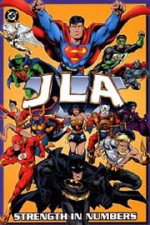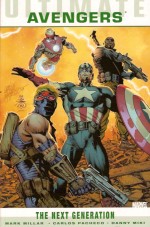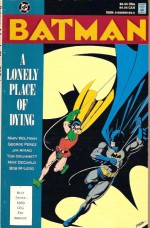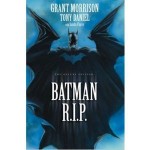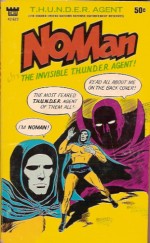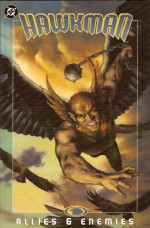
By Geoff Johns, James Robinson, Rags Morales & various (DC Comics)
ISBN: 978-1-4012-0196-8
After a cracking start to his own series (see Hawkman: Endless Flight) the reincarnating Winged Warrior offered even more thrills, chills and spills as his new series progressed. One of DC’s most visually iconic characters, the various iterations of Hawkman had always struggled to find enough of an audience to sustain a solo title. From his beginnings as the second feature in Flash Comics, the Feathered Fury struggled through many excellent yet always short-lived reconfigurations. From ancient hero to space-cop and (post-Crisis on Infinite Earths) Thanagarian freedom fighter Hawkman (and Hawkgirl) never quite hit the big time they deserved.
Hawkman premiered in Flash Comics #1 (January 1940), created by Gardner Fox and Dennis Neville, with Sheldon Moldoff and Joe Kubert carrying on the strip’s illustration, whilst a young Robert Kanigher was justly proud of his later run as writer. Carter Hall was a playboy archaeologist until he uncovered a crystal knife that unlocked his memories. He realised that once he was Prince Khufu of ancient Egypt and that he and his lover Chay-Ara had been murdered by High Priest Hath-Set. Moreover with his returned memories came the knowledge that both lover and killer were also nearby and aware…
Hall fashioned a costume and anti-gravity harness, becoming a crime-fighting phenomenon. Soon the equally reincarnated Shiera Sanders was fighting and flying beside him as Hawkgirl. Together these gladiatorial “Mystery-Men†battled modern crime and tyranny with weapons of the past.
Fading away at the end of the Golden Age (his last appearance was in All Star Comics #57, 1951 as leader of the Justice Society of America) they were revived nine years later as Katar Hol and Shayera Thal of Thanagar by Julie Schwartz’s crack creative team Gardner Fox and Joe Kubert – a more space-aged interpretation which survived until 1985’s Crisis, and their long career, numerous revamps and retcons ended during the 1994 Zero Hour crisis.
When a new Hawkgirl was created as part of a revived Justice Society comic, fans knew it was only a matter of time before the Pinioned Paladin rejoined her, which he did in the superb JSA: the Return of Hawkman , promptly regaining his own title. This time the blending of all previous versions into a reincarnating, immortal berserker-warrior appeared to strike the right note of freshness ad seasoned maturity. Superb artwork and stunning stories didn’t hurt either (for which see the excellent previous volume Hawkman: Endless Flight).
The reconstituted Hawkman now remembers all his past lives: many millennia when and where he and Chay-Ara fought evil together as bird-themed champions, dying over and over at the hands of an equally renewed Hath-Set. Most importantly, Kendra Saunders, the new Hawkgirl differs from all previous incarnations. This time Shiera was not reborn, but possessed the body of her grand-niece when that tragic girl committed suicide. Although Carter Hall still loves his immortal inamorata his companion of a million battles is no longer quite so secure or sure of her feelings…
This second captivating volume reprints issues #7-14 of the monthly comicbook and further gems from the one-shot Hawkman Secret Files, beginning with a fascinating reunion between the Pinioned Paladin and his one-time best friend the Atom. ‘Small Talk’ by Geoff Johns, Rags Morales, Prentiss Rollins & Michael Bair has the old comrades rediscover each other by recapping the momentous events that have transpired whilst Carter Hall was dead – useful and insightful for new readers – all whilst Hawkgirl tracked down a super-miscreant for the ever-so grateful Chief Nedal of the St. Roch police.
James Robinson rejoined the creative cast for ‘In the Hands of Fate’. The convoluted history of the Hawks threatened their effectiveness and happiness, and Dr. Fate intended to fix their problems, but before any resolution, the body of Kendra Saunders – which housed the spirit of Egyptian princess Chay-Ara – was confronted by long-suppressed memories of a brutal assault: an experience which led to her suicide and rebirth as Hawkgirl. Meanwhile the mystic master dragged Carter through his own panorama of horrific remembrances…
Before the esoteric therapy session could conclude the Hawks were propelled into a calamitous battle in the Himalayas against their oldest foe in a fresh new guise. ‘Snowblind’ saw Winged Wonders battle an army of killer yeti to recue aged adventurer Speed Saunders, whilst in ‘Everlasting Love…?’ the heroes unveiled a secret weapon of their own to thwart the malevolent mastermind, but sadly, too late as the terrifying transformation an already efficient enemy into ‘The Darkraven’ (with additional inks from Dennis Janke) upset everybody’s plans and threatened all of Tibet. Even after their narrow victory greater shocks and horrors were awaiting their return to Louisiana…
‘Fine Day For a Hanging’ (illustrated by Tim Truman) delved into a past life of the heroes, revealing that once Carter and Shiera had fought injustice as the masked gunfighter Nighthawk and frontier legend Cinnamon. Not only is this ripping yarn a cracking cowboy romance and stunning change of pace, but it also serves to set up the compelling saga which follows…
Arrested for murdering a cop, Kendra is being taken to prison by Chief Nedal when events take an utterly unexpected turn. ‘Killers’ (Johns, Ethan Van Sciver & Mick Gray) revealed that the cop had concealed a startlingly intimate connection to Kendra that stretched back to her earliest years. Now Nedal has gone completely over the edge…
Naturally there are secrets within secrets and phantom villain the Gentleman Ghost smugly reveals how – and why – he has been orchestrating the Hawks’ woes and miseries for over a century in ‘Killers Part Two’ (with art from Don Kramer & Rollins) – a tense and tragic thriller that could only end in the spilling of innocent blood …
Grim, gripping, stark and uncompromising, these are some of the most stirring episodes in the high-flying heroes’ seventy-odd year history and still the best is yet to come. Absolutely unmissable superhero sagas for older fans and novices alike, Enemies and Allies is a magnificent, beautiful and compelling example of what great creators and fresh ideas can achieve with even the oldest raw material.
© 2002, 2003 DC Comics. All Rights Reserved.


